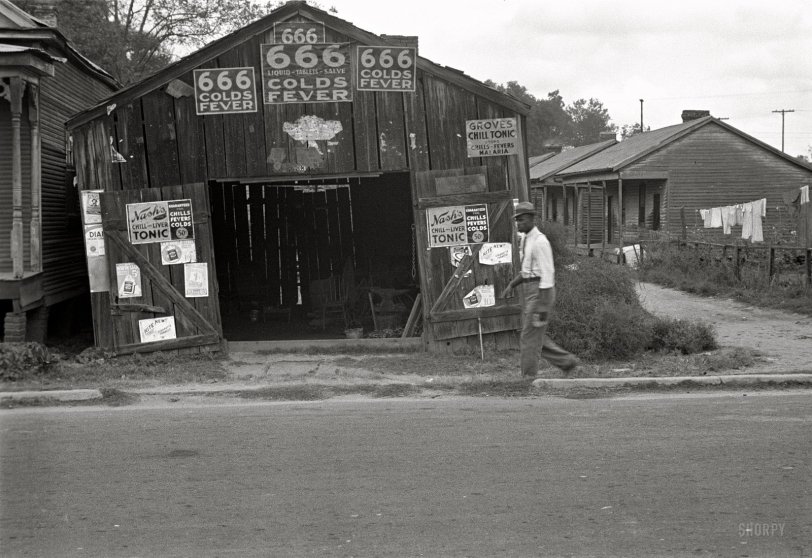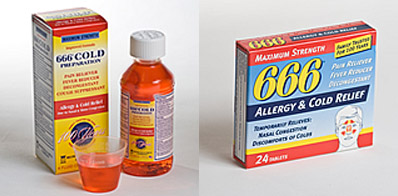


Framed or unframed, desk size to sofa size, printed by us in Arizona and Alabama since 2007. Explore now.
Shorpy is funded by you. Patreon contributors get an ad-free experience.
Learn more.

- Baldwin 62303
- Baldwin VO-1000
- Cold
- No expense spared
- Tough Guys
- Lost in Toyland
- And without gloves
- If I were a blindfolded time traveler
- Smoke Consumer Also Cooks
- Oh that stove!
- Possibly still there?
- What?!?
- $100 Reward
- Freeze Frame
- Texas Flyer wanted
- Just a Year Too Soon
- WWII -- Replacing men with women at the railroad crossing.
- Yes, Icing
- You kids drive me nuts!
- NOT An Easy Job
- I wonder
- Just add window boxes
- Icing Platform?
- Indiana Harbor Belt abides
- Freezing haze
- Corrections (for those who care)
- C&NW at Nelson
- Fallen Flags
- A dangerous job made worse
- Water Stop
Print Emporium
The Cure: 1935

October 1935. "Advertisements for popular malaria cure. Natchez, Mississippi." Photo by Ben Shahn for the Farm Security Administration. View full size.
It ain't that long gone
Three Sixes, Black Draught, and Cardui were still features of my childhood, in 1960s rural Texas. They also gave away wall calendars by the thousands through local drugstores, and it was quite common to see a Black Draught calendar hanging in working-class homes, used as a kind of domestic diary.
Mom's cure-all
My mom grew up in Jackson, Mississippi, in the 1930s and 1940s. While raising me in Canton, Ohio, she always kept "Three Sixes" in the house and dosed me with it whenever I had a cold. It tasted awful and the bright yellow color didn't help. I had no idea it was a malaria cure! Thanks for the insight; I love this site!
Three Sixes
I used to hear a lot of radio ads for 666, especially on stations carrying the farm market reports, in the 50's and 1960's -- my prime radio listening decades. 666 was often advertised along with Black Draught Laxative.
I don't believe the biblical connection with the triple 6's was a big thing back then. Public consciousness about that three-digit number has grown along with the rise of Protestant fundamentalism, beginning (generally speaking) in the 70's.
Pharmacists to the Beast
The early versions of the Pure Food and Drug Act did little to control the claims of the patent medicine manufacturers, or even to limit the inclusion of potentially dangerous substances in medicinal concoctions. The primary purpose of the Act was to require that all ingredients be listed on the packaging, still an important feature today. And some of those early ingredients were hair-raising by today's standards. For example, some of the most popular cough syrups in the Teens and Twenties included such ingredients as creosote (an expectorant), strychnine nitrate (a heart stimulant) and opium (good for most anything what ails you). Some of these proprietary medicines probably did help people. Others succeeded by aggressive advertising rather than by effective results. And it wasn't until the 1960s that "Carter's Little Liver Pills" were required to become "Carter's Little Pills."
Whoa, Nelly
Judging by the way the building is leaning precariously to the side, methinks it may not be well. Someone better check for a coated tongue, yellow complexion, bad breath, and restlessness at night. But which tonic to dose it with?
Nash's Chill and Liver Tonic
The following advertisement for Nash's Chill and Liver Tonic was reprinted in the May 2007 issue of The Sandyland Chronicle.
MALARIA IS ONE OF CHIEF CAUSES OF
LAZINESS IN THE SOUTHStatistics prove that there are more deaths caused by MALARIA than by automobiles and it is a fact that most of these deaths could be prevented if treatment had been given in time. There are thousands of people who have Malaria and do not recognize it until it has sapped their vitality and put their system in a weakened condition.
The South has a reputation for being lazy. It is not the climate so much as it is disease — the dreaded Malaria that gives that tired, worn out, achy feeling. Constipation and biliousness are caused by this disease and make one sluggish and without usual energy.
Recent years have given us a new discovery—in fact, the greatest discovery in the annals of medicine for malaria infested districts in our South. The new discovery, NASH’S CHILL AND LIVER TONIC, is the result of many years experience and experiments to correct the two main troubles of Southern people, malaria and biliousness. Chills and malaria can now be controlled and prevented if the right treatment is taken in time. NASH’S CHILL AND LIVER TONIC is pleasant to take, stimulates the glands of the liver, and evacuates the lower bowel. At the same time, it combats the malaria germ! It increases the appetite, aids digestion and puts red corpuscles in your blood, and best of all, gives you the pep and energy you are lacking.
This tonic is highly endorsed. Though just introduced in Camden, dozens of bottles have been sold with astonishing results. Numerous testimonials are being received by the manufacturers almost daily attesting to the wonderful merits of this discovery. Local druggists who are selling this preparation are surprised at the enormous sales and the satisfaction which it gives their customers.
And, this tonic is absolutely guaranteed. Take a few doses and if you are not satisfied with results, your druggist will gladly refund your money.
Look out for these symptoms: If you are tired all the time—hate to get up in the morning — feel lazy and no account—have headache or backache—floating specks before the eyes — are nervous — stomach out of order. If you have any of these symptoms, you are no doubt affected by malaria and biliousness, so don’t wait. Order a bottle of NASH’S CHILL AND LIVER TONIC and note the improvement after a very few doses. Some people are so foolish as to wait until they have a chill to begin treatment. This is the wrong idea as it is better to prevent the chill that to have to cure
Warning to Mothers: Watch your children! Perhaps they need this tonic. Don’t wait until they have chills to begin treatment. Watch the youngsters—if they seem cross and unruly, don’t spank—they probably are not well. Watch for the coated tongue, yellow complexion, bad breath, restless at night. Give a few doses of this wonderful tonic and note how quick it will put roses in their cheeks. Absolutely harmless, and pleasant to take.
Ask doctor about this formula: NASH’S TONIC contains the most active Alkaloid of Cinehons called “Ouinidine”—tasteless quinine. This ingredient kills malaria germs. It also contains the extract of Podophyllum, commonly called May Apple, which produces a more frequent flow of bile, this stimulating the glands of the liver. It also contains Phenolphthelein, which evacuates the lower bowel, thereby eliminating all poisons and waste matter from the system.
Price: 50 cents per bottle. If not satisfied, purchase price will be refunded without question.
Camden Evening News, September 14, 1928
Tilt
That's a real slanty shanty, to quote Sluggo.
Devil of a tonic
Seems tonic was a big product in Natchez. Wonder just what proof these elixirs were? There are no fewer than three different brands advertised on that shack: Nash's chill and liver tonic, Grove's chill tonic, and my personal favorite: 666 liquid tablets and salve. I thought the Pure Food and Drug act did away with such products (at least their claims to cure specific ailments) well before 1935, but I guess not in rural Mississippi. I would also think the repeal of Prohibition would have cut into their appeal. But I guess the temperance movement in the South lasted longer than the 21st amendment. I can just hear some old granny saying "that's not booze, that's medicine." Yeah, right, Granny.
[These anti-malarial remedies, according to their advertising, contained quinine and an iron supplement, but no alcohol. - Dave]
666
The Triple 6 brand is now owned by Monticello Drug Co.

That building
I think we've found the Acme Cartoon Warehouse. Anvil, buckets, chain - what else do you need?
























On Shorpy:
Today’s Top 5